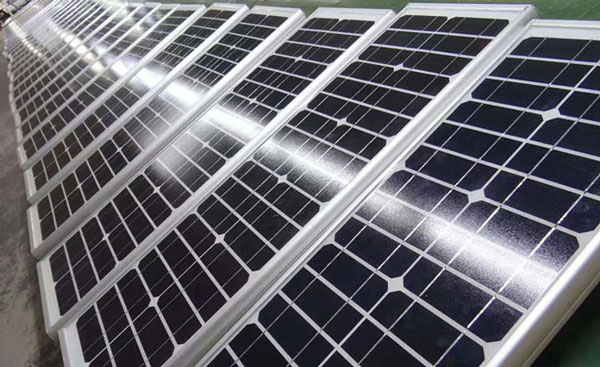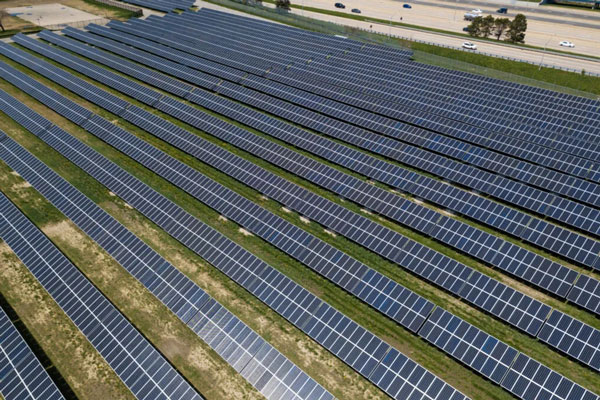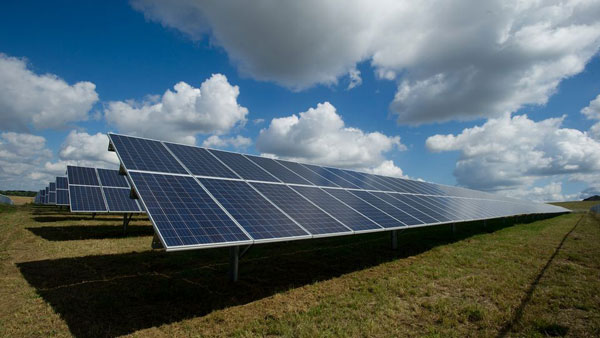Perovskite Technology
Perovskite solar cells have made remarkable progress in photovoltaic research due to their high efficiency and low production cost. The material, which takes its name from the mineral that have similar crystal structure, can be synthesised through various simple and low-cost methods. Efficiencies for perovskite cells have reached a maximum of 25.5%, not far from the ones of the monocrystalline silicon cells commonly used today, which reach about 26%. The reason for the recent and rapid success of perovskite cells, from initial efficiency of 3.8% in 2009, is that its characteristics hold potentials that might well change the future of solar technology and production.

Low-Cost manufacturing
One of the strongest points of the technology outside of its efficiency is that it is cheap and easy to manufacture. Among the various ways that can be implemented to deposit the film, that is precipitation and solution processing is the most cost-effective one. In solution processing, the material is dissolved within some solvent, which is then used to spin or spray the thin film on a substrate, in a simple way. Silicon cells require single-crystalline and photolithographic techniques as well as high-purity production of silicon, a costly and complex process.
Versatility and Applications
The use of perovskite cells might not only be applied to silicon cells or equivalent, but also be carried out on such surfaces as plastics, glass, and metal sheets. Ultimately, the cells might be used as BIPVs building-integrated photovoltaics, for generation strips on furniture or vehicles, and foldable, flexible, or rollable pannels. Another applicability feature is that perovskites are suitable for indoor use, as they do not need much light to function. Most prominent photovoltaic cells do not work well without sunlight and their use as domestic source of power, albeit often posted, has limited uses.
Challenges of dubious durability
Most materials can be easily and cheaply manufactured and are already are applicated in various fields, but that was not the first, nor the second nor even close to the seventh reason why they have not been. The major problem that have prevented the use of cells in areas with high moisture, continuous sun exposure or heat is that until relatively recently the optimal cell would last days or weeks before failing. If the cells cannot hold integrity for at least several years, their use outside of a few niches will be severely limited. Encapsulation techniques and materials that are immune to environmental effect have been developed that can extend the lifespan of perovskite cells to up to twenty years at around one third of their efficiency. These are not yet well usable, as efficiency of solar cells still is an important factor and will remain so in the future.
Quantum Dots
Quantum dots are nanoscale semiconductor particles whose unique optical and electronic properties are due to the quantum mechanical effects that occur within them. One key property is the ability to adjust size and control the band gap, allowing quantum dots to convert solar energy into electricity across a wider range of wavelengths than typical photovoltaic materials. Although quantum dots can absorb and emit light of different wavelengths, known as photoluminescence, for purposes of solar energy conversion, they would be size-tuned so as to optimise overall solar light spectrum utilization. In addition, smaller quantum dots would absorb higher energy photons and re-emit them as lower energy photons. This means that quantum dots can potentially increase solar cell conversion efficiencies by more than when compared to traditional silicon cells, which receive a similar range of light but only able to capture one portion, although increasing in efficiency in recent years has demonstrated comparable levels.
Quantum Dot Sensitized Solar Cells and Efficiency
The use of quantum dots in the active layer of solar cells has resulted in their incorporation into so-called quantum dot sensitized solar cells. LDSSCs have demonstrated greater than a 3% increase in laboratory level efficiency, showing the technology in the lab to have an efficiency of over 13%, which is a large improvement over the previous figures for some thin film technologies. The major reason for higher efficiencies is that a workforce capable of harnessing both high and low energy photons, which demonstrates improvements in energy conversion efficiency. After carrying out in situ synthesis of quantum dots in layer-by-layer depositions, quantum dots can be readily introduced.
Synthesis and Integration
So, typically, quantum dots are chemically synthesised in solution. This solution process is amenable to large scale manufacturing of quantum dots as compared to traditional silicon-type manufacturing, in addition to being done at much lower temperatures than traditional use, which often occurs at high temperatures. Quantum dots can then be incorporated in more production methods, such as layer-by-layer deposition, which is ideal for making an even quantum dot layer. Stability is a major concern when using quantum dot solar cells, due mainly to the oxidative degradation of quantum dots when exposed to air and light.
Challenges and Innovations in Stability
In terms of challenges, quantum dot solar cells are the most stable because they degrade quantum dots into the air when exposed to air and light. A novel example to this is the creation of inorganic ligands that protect quantum dots from the coulomb crisis of oxygen and moisture. In addition to this, perovskite is used as an overcoat, as seen in some cells, where the subsequent layers must demonstrate improved efficiency and reduced degradation when banded together. This is not currently understood the mechanism behind this. It is clear that as research advances, quantum dots will play a critical role in the ongoing development of the next generation of solar cells. They will be integrated into established technologies to counter the upper efficiency limits of currently available photovoltaic technologies. A promising technology likely to be used alongside tandem solar cells, where quantum dots are used in conjunction with traditional sky apparatus. As a result, transformational improvements in solar panel production could bring efficiency and cost parity closer to commercial solar equipment.
Bifacial Solar Cells
Bifacial cells refer to a technology of solar energy collection that allows the cells to collect the sunlight not only from the traditional front but also from the backside. It means that the energy yield of these cells is almost double of that of a monofacial solar cell. Bifacial solar cells collect energy both from direct light and from the reflection from the ground or other nearby surface. Below, this paper describes the operation of the bifacial technology, its design, installation, deployment, and potential impact.
Operation and Application
Bifacial cells differ from monofacial cells in the ability to absorb light and heat from two surfaces. The existence of a second layer of energy collection allows energy yield to grow by up 30% under the right lighting conditions. The highest increase in energy generation occurs in the areas with highly reflective ground, such as sand or snow. The contribution of the back side of the cell is estimated to be within 6-25% range of the total power output depending on the albedo of the surrounding surface. This power can be substiantially greater in elevated panels over dry fields, for example. However, any shadowing, mud, snow, or water accumulation that may obstruct lighting on the premounted aft surface can decrease the generation.
Installation
There are a number of requirements for the installation of bifacial solar panels and their mounting system. The most essential requirement is the uninterrupted lighting of the back side of the panel. Therefore, bifacials should be installed on elevated racks, above reflective surfaces, above snow, mud, and cooled, lowered grass under the panel. The proper till and the proper installation of the panels allows receiving up to 27% more energy. It is also vital to properly space the panels as shadow can substantially diminish the effects of the back side of the panels.
Economic and Environmental Impact
First, bifacial technology allows for more energy to be produced by solar installations which, in turn, allows to receive more energy from the same footprint and increases the revenue from the investment. Such installations become much more viable and more competitive and can gain widespread practice in utility-scale applications, for example. One theoretical disadvantage of this technology is related to the higher energy input in the production of the secondary layers. Furthermore, the increased energy production per square meter can lead to the reduced total area use of solar plants, therefore, potentially, lowering the overall environmental and fauna impact.
Transparent Solar Panels
Transparent solar panels are a revolutionary innovation in the field of solar technology. They make it possible for windows, skylights, and facades to generate electricity while still maintaining their transparency. These solar panels are made from organic materials and specifically designed microstructures which allow them to capture the solar energy that is present, all without obstructing the light.
Technology and Mechanism
Transparent solar technologies generally use OPVs or otherwise, thin film cells like perovskite. The materials and microstructures of the panels are designed to allow the visible spectrum to go through and be visible, while they absorb the UV and the infrared light. Selective light absorption is critical for panels to generate electricity while staying invisible.
Integration into Architecture
Even though transparent solar panels are functionally identical to ordinary glass, they still do not compromise the architectural process in the building. A number of building’s glasses can be replaced by the innovative panels. In addition to this, they can be incorporated directly into the inner perimeter of the building envelope. The panels are especially effective for high-rise buildings, as they often have very large amounts of surface area covered by glass. Architects and engineers can build with the intent to maximize the reach of solar energy while optimizing light entry to the building.
Efficiency and Output
While the efficiency for an ordinary, traditional solar panel would be about 15-20%, transparent solar panels generally work at about 5-10% efficiency. However, the panels make up for the lower efficiency by being able to be integrated at a much higher surface area transparent surface levels. Breakthroughs in the studies on the technology will increase the efficiency, making the rates closer to those of conventional solar panels.
Economic and Environmental Benefits
A dual-purpose of the transparent solar panels is their capability of perceiving both functions: generating energy and the direct transmission of sunlight. This leads to significant savings on both expenses of energy and materials. In regards to energy use, the panels rely on the electricity their build themselves, which means that the user does not rely on additional energy sources. Environmentally, not needing energy from additional sources means that the user does not spend them, and the panels reduce the overall carbon footprint because of this.

Flexible Solar Cells
Flexible solar cells are among the most progressive solutions regarding solar energy. The trick of their effectiveness and unique features lies in their ability to bend and adjust to the form of any surface. Such cells are generally made of thin-film materials, such as amorphous silicon, cadmium telluride, and organic photovoltaics. Naturally, such materials are significantly lighter and more flexible compared to traditional rigid silicon wafers.
Additional manufacturing processes and materials
The ability to maintain their flexibility is based on various materials and methods of their manufacturing. First, as it has been mentioned, thin-film solar cells are deposited on such flexible substrates as plastic, metal foil, and even paper. Their manufacturing sequence also employs a technique called roll-to-roll processing.
The production of thin-film solar cells on the flexible substrates allows them to be very lightweight and flexible, which are the features that ensure their unique “softness” and bendability. What is more, from an economic perspective, the manufacturing of these cells is also much more economical than the production of rigid cells.
Applications and level of flexibility
Conditions of their applications also depend on their level of flexibility. The potential applications for these cell types go far beyond the capacity of the rigid cells. They may be integrated into clothes, portable chargers, or temporary installations. What is more, they are much more adaptable to certain surfaces; for example, they are incredibly useful on vehicle or building surfaces with complex curvature. Although the efficiency level of the flexible cells is not as high as for standard ones, the continuous advancement in this domain provides the support that this gap will be closed in the future. As the economic value of the manufacturing these cells tends to decrease, there is a high probability of their mass production and their wide-scaled implementation throughout the world.



